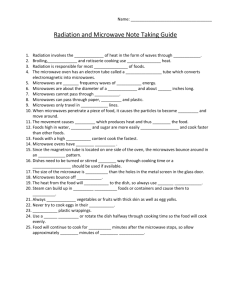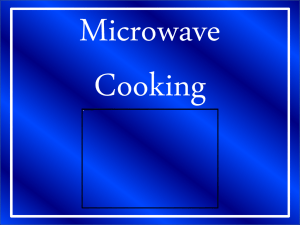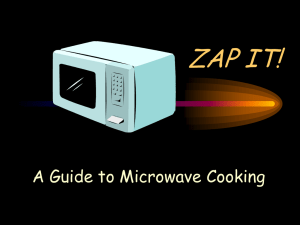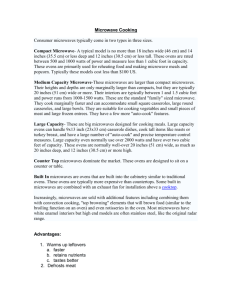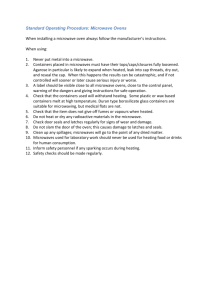MICROWAVE COOKING
advertisement
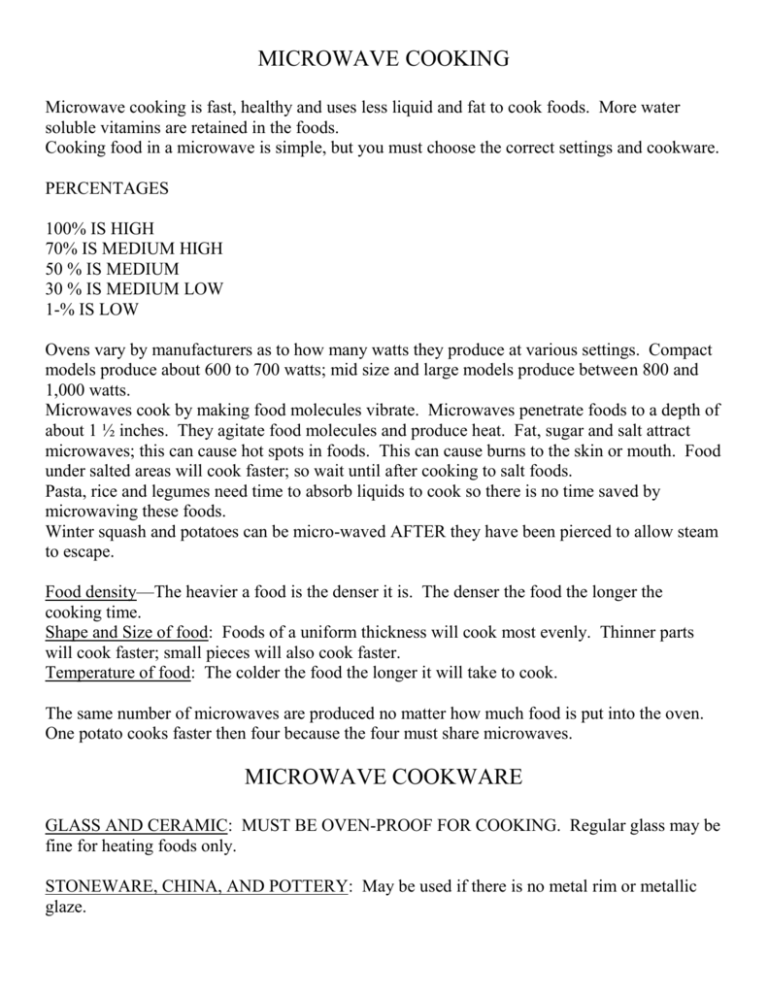
MICROWAVE COOKING Microwave cooking is fast, healthy and uses less liquid and fat to cook foods. More water soluble vitamins are retained in the foods. Cooking food in a microwave is simple, but you must choose the correct settings and cookware. PERCENTAGES 100% IS HIGH 70% IS MEDIUM HIGH 50 % IS MEDIUM 30 % IS MEDIUM LOW 1-% IS LOW Ovens vary by manufacturers as to how many watts they produce at various settings. Compact models produce about 600 to 700 watts; mid size and large models produce between 800 and 1,000 watts. Microwaves cook by making food molecules vibrate. Microwaves penetrate foods to a depth of about 1 ½ inches. They agitate food molecules and produce heat. Fat, sugar and salt attract microwaves; this can cause hot spots in foods. This can cause burns to the skin or mouth. Food under salted areas will cook faster; so wait until after cooking to salt foods. Pasta, rice and legumes need time to absorb liquids to cook so there is no time saved by microwaving these foods. Winter squash and potatoes can be micro-waved AFTER they have been pierced to allow steam to escape. Food density—The heavier a food is the denser it is. The denser the food the longer the cooking time. Shape and Size of food: Foods of a uniform thickness will cook most evenly. Thinner parts will cook faster; small pieces will also cook faster. Temperature of food: The colder the food the longer it will take to cook. The same number of microwaves are produced no matter how much food is put into the oven. One potato cooks faster then four because the four must share microwaves. MICROWAVE COOKWARE GLASS AND CERAMIC: MUST BE OVEN-PROOF FOR COOKING. Regular glass may be fine for heating foods only. STONEWARE, CHINA, AND POTTERY: May be used if there is no metal rim or metallic glaze. PLASTIC: USE ONLY MICROWAVE SAFE ITEMS; IF THEY ARE NAOT THEY WILL MELT YOUR FOOD PAPER: Paper plates may be used if they are strong enough to hold food. Styrofoam will melt in the microwave. Do not use recycled paper produces as they may contain metal fragments and chemicals that catch fire. The size and shape of the cookware will affect the way foods cook and the cooking time. Pans should be shallow and have straight edges. Round pans allow for even cooking. Rectangular and square pans should have rounded corners. METAL AND FOIL: Can cause arcing; electrical sparks that will damage the oven and cause a fire. NEVER LEAVE A METAL UTENSIL IN FOOD TO BE MICROWAVED COOKING TIPS Arrange food in a circle or ring shape if possible. Foods that are uneven; place thickest part on the outside of the ring and the thinner part towards the outside. For example; a chicken leg; the bony end toward the center and the thicker part toward the outside. Covering food holds the steam, keeps food moist, and shortens cooking time. This also keeps food from spattering. Some foods need to be stirred, rotated, or turned during cooking because microwaves are not always distributed evenly. Most new ovens have a turntable that rotate the food for you. Microwave cooking has two parts; the first part is the microwave process when the microwaves are being produced. The second part is standing time; where the heat that has built up in the food completes the cooking. Check for doneness after the standing time NOT before it. To adapt a standard recipe to microwave it is best to find a microwave recipe that is very close or similar and convert the recipe from that. ACCIDENT PREVENTION Never turn on a microwave that is empty. Follow manufacturer’s directions Do not reuse one use containers Loosen tight fitting lids before microwaving Never attach microwaves to the surface of a microwave; it will affect the controls Use hot pads or mitts even if you do not think the container of plate will be hot. CLEAN SPOTS AND SPILLS right after use; if allowed to build up the mess will absorb microwaves and cut down cooking times. Bacteria will also grow there. Wipe with a soft, wet, clean dishcloth and DO NOT USE ANY ABRASIVE CLEANERS.
